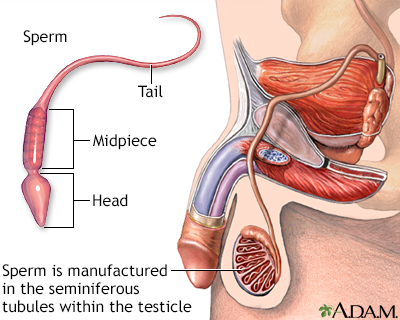Testes
The testes are 2 egg-shaped male reproductive organs located in the scrotum. They produce sperm and the male hormone, testosterone.
Scrotum
The scrotum is a part of a male's body that is located below the penis. The scrotum is the sac (pouch) that contains the testes, epididymis, and the...

Testosterone
A testosterone test measures the amount of the male hormone, testosterone, in the blood. Both men and women produce this hormone. The test described...
Read Article Now Book Mark ArticleVideo Transcript
Sperm release pathway - Animation
The key male reproductive organs include the testes, epididymis, urethra, vas deferens, prostate gland, seminal vesicle, and penis. The testes are composed of coiled structures called seminiferous tubules, which are the sites of sperm production. The structure on top of the seminiferous tubules in the testes is the epididymis. The sperm migrate from of the seminiferous tubules to the epididymis. Within the epididymis, the sperm mature while they are stored in this structure. The ejaculation process begins as the penis fills with blood and becomes erect. With sufficient stimulation, mature sperm travel from the epididymis through the vas deferens, a muscular tube, which propels sperm forward through smooth muscle contractions. The sperm arrive first at the ampulla, where secretions from the seminal vesicle are added. From the ampulla, seminal fluid is propelled forward through the ejaculatory ducts toward the urethra, passing first by the prostate gland, where a milky fluid is added to form semen. Finally, the semen is ejaculated through the far end of the urethra.
Reviewed By
Kelly L. Stratton, MD, FACS, Associate Professor, Department of Urology, University of Oklahoma Health Sciences Center, Oklahoma City, OK. Also reviewed by David C. Dugdale, MD, Medical Director, Brenda Conaway, Editorial Director, and the A.D.A.M. Editorial team.
Donohoue PA. Development and function of the gonads. In: Kliegman RM, St. Geme JW, Blum NJ, Shah SS, Tasker RC, Wilson KM, eds. Nelson Textbook of Pediatrics. 21st ed. Philadelphia, PA: Elsevier; 2020:chap 600.
Kavoussi PK. Surgical, radiographic, and endoscopic anatomy of the male reproductive system. In: Partin AW, Dmochowski RR, Kavoussi LR, Peters CA, eds. Campbell-Walsh-Wein Urology. 12th ed. Philadelphia, PA: Elsevier; 2021:chap 63.
McKenney JK. Testis and testicular adnexa. In: Goldblum JR, Lamps LW, McKenney JK, Myers JL, eds. Rosai and Ackerman's Surgical Pathology. 11th ed. Philadelphia, PA: Elsevier; 2018:chap 27.
Disclaimer



 All rights reserved.
All rights reserved.